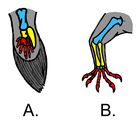رباعيات الأرجل
| رباعيات الأرجل Tetrapods | |
|---|---|
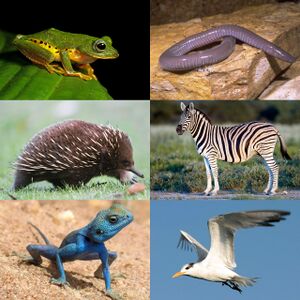
| |
| Clockwise from top left: Mercurana myristicapaulstris, a shrub frog; Dermophis mexicanus, a legless amphibian; Equus quagga, a plains zebra; Sterna maxima, a tern (seabird); Pseudotrapelus sinaitus, a Sinai agama; Tachyglossus aculeatus, a short-beaked echidna | |
| التصنيف العلمي | |
| أصنوفة غير معروفة (أصلحها): | الحياة |
| مملكة: | الحيوانية |
| Phylum: | حبليات |
| Infraphylum: | فكيات |
| Clade: | فكيات_حقيقية |
| Clade: | فقاريات_فكية |
| Superclass: | فقاريات_رباعية_الأطراف Hatschek & Cori, 1896 [Laurin][3][4] |
| المجموعات الفرعية | |
وانظر النص | |
تحت صف رباعيات الأرجل Tetrapoda (باليونانية القديمة τετραπόδηs tetrapodēs، "رباعيات الأرجل")، تمثل أول الفقاريات رباعية الأرجل وسلالاتها، وتشمل البرمئيات، الزواحف، الطيور، والثدييات الحية والمنقرضة. نشأت رباعيات الأرجل من لحميات الزعانف منذ حوالي 395 مليون سنة ضت في العصر الديڤوني.[5] الأسلاف المائية المحددة لرباعيات الأرجل، والعملية التي تم بواسطتها الاستعمار البري، لا تزال غير واضحة، وهي محور أبحاث وجدل لا يزال دائراً بين علماء الأحفورات حتى الآن.[6] Tetrapods include all extant and extinct amphibians and amniotes, with the latter in turn evolving into two major clades, the sauropsids (reptiles, including dinosaurs and therefore birds) and synapsids (extinct pelycosaurs, therapsids and all extant mammals). Some tetrapods such as snakes, legless lizards, and caecilians had evolved to become limbless via mutations of the Hox gene,[7] although some do still have a pair of vestigial spurs that are remnants of the hindlimbs.
Tetrapods evolved from a group of primitive semiaquatic animals known as the Tetrapodomorpha which, in turn, evolved from ancient lobe-finned fish (sarcopterygians) around in the Middle Devonian period;[8] their forms were transitional between lobe-finned fishes and true four-limbed tetrapods. Limbed vertebrates (tetrapods in the broad sense of the word) are first known from Middle Devonian trackways, and body fossils became common near the end of the Late Devonian but these were all aquatic. The first crown-tetrapods (last common ancestors of extant tetrapods capable of terrestrial locomotion) appeared by the very early Carboniferous, 350 million years ago.[9]
The specific aquatic ancestors of the tetrapods and the process by which they colonized Earth's land after emerging from water remains unclear. The transition from a body plan for gill-based aquatic respiration and tail-propelled aquatic locomotion to one that enables the animal to survive out of water and move around on land is one of the most profound evolutionary changes known.[10][11] Tetrapods have numerous anatomical and physiological features that are distinct from their aquatic fish ancestors. These include distinct head and neck structures for feeding and movements, appendicular skeletons (shoulder and pelvic girdles in particular) for weight bearing and locomotion, more versatile eyes for seeing, middle ears for hearing, and more efficient heart and lungs for oxygen circulation and exchange outside water.
The first tetrapods (stem) or "fishapods" were primarily aquatic. Modern amphibians, which evolved from earlier groups, are generally semiaquatic; the first stages of their lives are as waterborne eggs and fish-like larvae known as tadpoles, and later undergo metamorphosis to grow limbs and become partly terrestrial and partly aquatic. However, most tetrapod species today are amniotes, most of which are terrestrial tetrapods whose branch evolved from earlier tetrapods early in the Late Carboniferous. The key innovation in amniotes over amphibians is the amnion, which enables the eggs to retain their aqueous contents on land, rather than needing to stay in water. (Some amniotes later evolved internal fertilization, although many aquatic species outside the tetrapod tree had evolved such before the tetrapods appeared, e.g. Materpiscis.) Some tetrapods, such as snakes and caecilians, have lost some or all of their limbs through further speciation and evolution; some have only concealed vestigial bones as a remnant of the limbs of their distant ancestors. Others returned to being amphibious or otherwise living partially or fully aquatic lives, the first during the Carboniferous period,[12] others as recently as the Cenozoic.[13][14]
One group of amniotes diverged into the reptiles, which includes lepidosaurs, dinosaurs (which includes birds), crocodilians, turtles, and extinct relatives; while another group of amniotes diverged into the mammals and their extinct relatives. Amniotes include the tetrapods that further evolved for flight—such as birds from among the dinosaurs, pterosaurs from the archosaurs, and bats from among the mammals.
Definitions
The precise definition of "tetrapod" is a subject of strong debate among paleontologists who work with the earliest members of the group.[15][16][17][18]
Apomorphy-based definitions
A majority of paleontologists use the term "tetrapod" to refer to all vertebrates with four limbs and distinct digits (fingers and toes), as well as legless vertebrates with limbed ancestors.[16][17] Limbs and digits are major apomorphies (newly evolved traits) which define tetrapods, though they are far from the only skeletal or biological innovations inherent to the group. The first vertebrates with limbs and digits evolved in the Devonian, including the Late Devonian-age Ichthyostega and Acanthostega, as well as the trackmakers of the Middle Devonian-age Zachelmie trackways.[8]
Defining tetrapods based on one or two apomorphies can present a problem if these apomorphies were acquired by more than one lineage through convergent evolution. To resolve this potential concern, the apomorphy-based definition is often supported by an equivalent cladistic definition. Cladistics is a modern branch of taxonomy which classifies organisms through evolutionary relationships, as reconstructed by phylogenetic analyses. A cladistic definition would define a group based on how closely related its constituents are. Tetrapoda is widely considered a monophyletic clade, a group with all of its component taxa sharing a single common ancestor.[17] In this sense, Tetrapoda can also be defined as the "clade of limbed vertebrates", including all vertebrates descended from the first limbed vertebrates.[18]
Crown group tetrapods
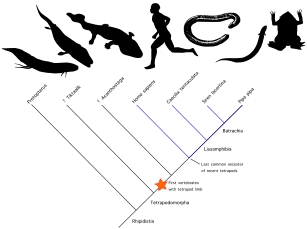
* Under the apomorphy-based definition used by many paleontologists, tetrapods originate at the orange star ("First vertebrates with tetrapod limb")
* When restricted to the crown group, tetrapods originate at the blue arrow ("Last common ancestor of recent tetrapods")
A portion of tetrapod workers, led by French paleontologist Michel Laurin, prefer to restrict the definition of tetrapod to the crown group.[15][19] A crown group is a subset of a category of animal defined by the most recent common ancestor of living representatives. This cladistic approach defines "tetrapods" as the nearest common ancestor of all living amphibians (the lissamphibians) and all living amniotes (reptiles, birds, and mammals), along with all of the descendants of that ancestor. In effect, "tetrapod" is a name reserved solely for animals which lie among living tetrapods, so-called crown tetrapods. This is a node-based clade, a group with a common ancestry descended from a single "node" (the node being the nearest common ancestor of living species).[17]
Defining tetrapods based on the crown group would exclude many four-limbed vertebrates which would otherwise be defined as tetrapods. Devonian "tetrapods", such as Ichthyostega and Acanthostega, certainly evolved prior to the split between lissamphibians and amniotes, and thus lie outside the crown group. They would instead lie along the stem group, a subset of animals related to, but not within, the crown group. The stem and crown group together are combined into the total group, given the name Tetrapodomorpha, which refers to all animals closer to living tetrapods than to Dipnoi (lungfishes), the next closest group of living animals.[20] Many early tetrapodomorphs are clearly fish in ecology and anatomy, but later tetrapodomorphs are much more similar to tetrapods in many regards, such as the presence of limbs and digits.
Laurin's approach to the definition of tetrapods is rooted in the belief that the term has more relevance for neontologists (zoologists specializing in living animals) than paleontologists (who primarily use the apomorphy-based definition).[18] In 1998, he re-established the defunct historical term Stegocephali to replace the apomorphy-based definition of tetrapod used by many authors.[21] Other paleontologists use the term stem-tetrapod to refer to those tetrapod-like vertebrates that are not members of the crown group, including both early limbed "tetrapods" and tetrapodomorph fishes.[22] The term "fishapod" was popularized after the discovery and 2006 publication of Tiktaalik, an advanced tetrapodomorph fish which was closely related to limbed vertebrates and showed many apparently transitional traits.
The two subclades of crown tetrapods are Batrachomorpha and Reptiliomorpha. Batrachomorphs are all animals sharing a more recent common ancestry with living amphibians than with living amniotes (reptiles, birds, and mammals). Reptiliomorphs are all animals sharing a more recent common ancestry with living amniotes than with living amphibians.[23] Gaffney (1979) provided the name Neotetrapoda to the crown group of tetrapods, though few subsequent authors followed this proposal.[18]
التنوع الحيوي
Tetrapoda includes three living classes: amphibians, reptiles, and mammals. Overall, the biodiversity of lissamphibians,[24] as well as of tetrapods generally,[25] has grown exponentially over time; the more than 30,000 species living today are descended from a single amphibian group in the Early to Middle Devonian. However, that diversification process was interrupted at least a few times by major biological crises, such as the Permian–Triassic extinction event, which at least affected amniotes.[26] The overall composition of biodiversity was driven primarily by amphibians in the Palaeozoic, dominated by reptiles in the Mesozoic and expanded by the explosive growth of birds and mammals in the Cenozoic. As biodiversity has grown, so has the number of species and the number of niches that tetrapods have occupied. The first tetrapods were aquatic and fed primarily on fish. Today, the Earth supports a great diversity of tetrapods that live in many habitats and subsist on a variety of diets.[25] The following table shows summary estimates for each tetrapod class from the IUCN Red List of Threatened Species, 2014.3, for the number of extant species that have been described in the literature, as well as the number of threatened species.[27]
| Tetrapod group | Image | Class | Estimated number of described species[27] |
Threatened species in Red List[27] |
Share of species scientifically described[27] |
Best estimate of percent of threatened species[27] |
|---|---|---|---|---|---|---|
| Anamniotes lay eggs in water |

|
Amphibians | 7,302 | 1,957 | 88% | 41% |
| Amniotes adapted to lay eggs on land |

|
Sauropsids (Birds and other Reptiles) |
20,463 | 2,300 | 75% | 13% |

|
Synapsids (Mammals) |
5,513 | 1,199 | 100% | 26% | |
| Overall | 33,278 | 5,456 | 80% | ? | ||
Classification
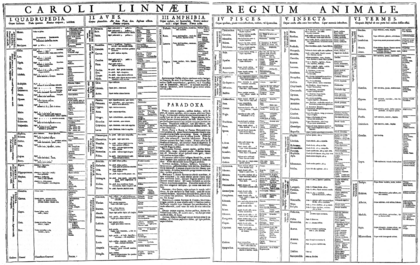
The classification of tetrapods has a long history. Traditionally, tetrapods are divided into four classes based on gross anatomical and physiological traits.[28] Snakes and other legless reptiles are considered tetrapods because they are sufficiently like other reptiles that have a full complement of limbs. Similar considerations apply to caecilians and aquatic mammals. Newer taxonomy is frequently based on cladistics instead, giving a variable number of major "branches" (clades) of the tetrapod family tree.
As is the case throughout evolutionary biology today, there is debate over how to properly classify the groups within Tetrapoda. Traditional biological classification sometimes fails to recognize evolutionary transitions between older groups and descendant groups with markedly different characteristics. For example, the birds, which evolved from the dinosaurs, are defined as a separate group from them, because they represent a distinct new type of physical form and functionality. In phylogenetic nomenclature, in contrast, the newer group is always included in the old. For this school of taxonomy, dinosaurs and birds are not groups in contrast to each other, but rather birds are a sub-type of dinosaurs.
History of classification
The tetrapods, including all large- and medium-sized land animals, have been among the best understood animals since earliest times. By Aristotle's time, the basic division between mammals, birds and egg-laying tetrapods (the "herptiles") was well known, and the inclusion of the legless snakes into this group was likewise recognized.[29] With the birth of modern biological classification in the 18th century, Linnaeus used the same division, with the tetrapods occupying the first three of his six classes of animals.[30] While reptiles and amphibians can be quite similar externally, the French zoologist Pierre André Latreille recognized the large physiological differences at the beginning of the 19th century and split the herptiles into two classes, giving the four familiar classes of tetrapods: amphibians, reptiles, birds and mammals.[31]
Modern classification
With the basic classification of tetrapods settled, a half a century followed where the classification of living and fossil groups was predominantly done by experts working within classes. In the early 1930s, American vertebrate palaeontologist Alfred Romer (1894–1973) produced an overview, drawing together taxonomic work from the various subfields to create an orderly taxonomy in his Vertebrate Paleontology.[32] This classical scheme with minor variations is still used in works where systematic overview is essential, e.g. Benton (1998) and Knobill and Neill (2006).[33][34] While mostly seen in general works, it is also still used in some specialist works like Fortuny et al. (2011).[35] The taxonomy down to subclass level shown here is from Hildebrand and Goslow (2001):[36]
- Superclass Tetrapoda – four-limbed vertebrates
- Class Amphibia – amphibians
- Subclass Ichthyostegalia – early fish-like amphibians (paraphyletic group outside leading to the crown-clade Neotetrapoda)
- Subclass Anthracosauria – reptile-like amphibians (often thought to be the ancestors of the amniotes)
- Subclass Temnospondyli – large-headed Paleozoic and Mesozoic amphibians
- Subclass Lissamphibia – modern amphibians
- Class Reptilia – reptiles
- Subclass Diapsida – diapsids, including crocodiles, dinosaurs, birds, lizards, snakes and turtles
- Subclass Euryapsida – euryapsids
- Subclass Synapsida – synapsids, including mammal-like reptiles-now a separate group (often thought to be the ancestors of mammals)
- Subclass Anapsida – anapsids
- Class Mammalia – mammals
- Subclass Prototheria – egg-laying mammals, including monotremes
- Subclass Allotheria – multituberculates
- Subclass Theria – live-bearing mammals, including marsupials and placentals
- Class Amphibia – amphibians
This classification is the one most commonly encountered in school textbooks and popular works. While orderly and easy to use, it has come under critique from cladistics. The earliest tetrapods are grouped under class Amphibia, although several of the groups are more closely related to amniotes than to modern day amphibians. Traditionally, birds are not considered a type of reptile, but crocodiles are more closely related to birds than they are to other reptiles, such as lizards. Birds themselves are thought to be descendants of theropod dinosaurs. Basal non-mammalian synapsids ("mammal-like reptiles") traditionally also sort under class Reptilia as a separate subclass,[28] but they are more closely related to mammals than to living reptiles. Considerations like these have led some authors to argue for a new classification based purely on phylogeny, disregarding the anatomy and physiology.
التطور
النشأة
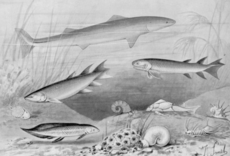



رباعيات أطراف الدهر القديم
رباعيات الأطراف الديڤونية

رباعيات الأطراف الطباشيرية
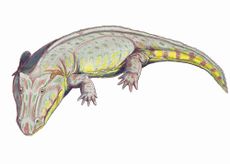
رباعيات الأطراف الپرمية

رباعيات أطراف الدهر الوسيط
رباعيات الأطراف الحية
- Lissamphibia: الضفادع والعلاجيم، السمندرات، والضفادع الثعبانية
- سلحفيات: السلاحف والسلاحف المائية
- Lepidosauria: tuataras، السحاليs, amphisbaenians والثعابين
- Crocodilia: التماسيح، القواطير، caimans and gharials
- الطيور الحديثة: الطيور الحديثة
- الثدييات: الثدييات
التصنيف
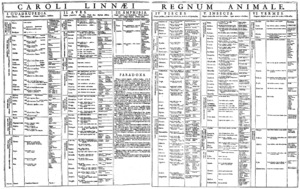
تاريخ التصنيف
التصنيف الحديث
- فوق صف رباعيات الأرجل - الفقاريات رباعية الأرجل
- الصف البرمائيات - البرمائيات
- تحت صف Ichthyostegalia - البرمئيات المبكرة شبيهة الأسماك
- تحت صف Anthracosauria - البرمئيات شبيه الأزواحف (ancestors of the amniotes)
- تحت صف Temnospondyli - large-headed Paleozoic and Mesozoic amphibians
- Subclass Lissamphibia - modern amphibians
- صف الزواحف - الزواحف، (سلالات منحدرة من الطيور والحيوانات)
- Subclass Anapsida - early reptiles
- تحت صف Synapsida - mammal-like reptiles, including the ancestors of mammals
- تحت صف Testudinata - turtles (may belong with diapsids)[37]
- تحت صف Diapsida - diapsids, including crocodiles, dinosaurs, lizards, and snakes
- صف الطيور - الطيور
- تحت صف Archaeornithes - ancestral tailed birds, e.g. Archaeopteryx
- تحت صف Enantiornithes - the most abundant Mesozoic birds, most with claws and teeth, but lacking a long tail
- تحت صف الطيور الحديثة - الطيور الحديثة
- صف الثدييات - الثدييات
- تحت صف Prototheria - monotremes
- تحت صف Allotheria - multituberculates
- تحت صف Theria - live bearing mammals
- الصف البرمائيات - البرمائيات
علم الإحاثة والتوزيع المبكر لذوات الأربع
العلاقات
رباعيات الأرجل الجذعية
المجموعة التاجية
فرضية مقسومات الفقار )
فرضية الليپوسپونديلايات
فرضية متعددة العرق
الخصائص التشريحية لرباعيات الأرجل المبكرة
الجمجمة
عدد الأسنان
أعضاء الحس
السمع
عظام الحوض
الأطراف
الحركة
التغذية
التنفس
الدورة الدموية
انظر أيضاً
المصادر
- ^ Irisarri, I., Baurain, D., Brinkmann, H. et al. Phylotranscriptomic consolidation of the jawed vertebrate timetree. Nat Ecol Evol 1, 1370–1378 (2017). https://doi.org/10.1038/s41559-017-0240-5
- ^ خطأ استشهاد: وسم
<ref>غير صحيح؛ لا نص تم توفيره للمراجع المسماةNiedźwiedzkiSzrek2010 - ^ Hatschek, B.; Cori, C. J. (1896). Elementarcus der Zootomie in fünfzen Vorlesungen [Elementary Zootomy in Fifteen Lectures] (in الألمانية). Jena: Gustav Fischer.
- ^ de Queiroz, K.; Cantino, P. D.; Gauthier, J. A., eds. (2020). "Tetrapoda B. Hatschek and C. J. Cori 1896 [M. Laurin], converted clade name". Phylonyms: A Companion to the PhyloCode. Boca Raton: CRC Press. pp. 759–764. ISBN 978-1-138-33293-5.
- ^ Clack 2012
- ^ قالب:Cite Merriam-Webster
- ^ Di-Poï, Nicolas; Montoya-Burgos, Juan I.; Miller, Hilary; et al. (2010-03-04). "Changes in Hox genes' structure and function during the evolution of the squamate body plan". Nature. 464 (7285): 99–103. doi:10.1038/nature08789. PMID 20203609. S2CID 205219752. Retrieved 2023-07-06.
- ^ أ ب خطأ استشهاد: وسم
<ref>غير صحيح؛ لا نص تم توفيره للمراجع المسماةNarkiewiczNarkiewicz2015 - ^ Hedges, S. B., Marin, J., Suleski, M., Paymer, M. & Kumar, S. Tree of Life reveals clock-like speciation and diversification. Mol. Biol. Evol. 32, 835–845 (2015).
- ^ Long JA, Gordon MS (Sep–Oct 2004). "The greatest step in vertebrate history: a paleobiological review of the fish-tetrapod transition". Physiol. Biochem. Zool. 77 (5): 700–19. doi:10.1086/425183. PMID 15547790. S2CID 1260442. Archived from the original on 2016-04-12. Retrieved 2011-04-09. as PDF Archived 2013-10-29 at the Wayback Machine
- ^ Shubin, N. (2008). Your Inner Fish: A Journey Into the 3.5-Billion-Year History of the Human Body. New York: Pantheon Books. ISBN 978-0-375-42447-2.
- ^ Laurin 2010, pp. 163
- ^ Canoville, Aurore; Laurin, Michel (June 2010). "Evolution of humeral microanatomy and lifestyle in amniotes, and some comments on paleobiological inferences". Biological Journal of the Linnean Society. 100 (2): 384–406. doi:10.1111/j.1095-8312.2010.01431.x.
- ^ Laurin, Michel; Canoville, Aurore; Quilhac, Alexandra (August 2009). "Use of paleontological and molecular data in supertrees for comparative studies: the example of lissamphibian femoral microanatomy". Journal of Anatomy. 215 (2): 110–123. doi:10.1111/j.1469-7580.2009.01104.x. PMC 2740958. PMID 19508493.
- ^ أ ب Laurin, Michel (2002-03-01). "Tetrapod Phylogeny, Amphibian Origins, and the Definition of the Name Tetrapoda". Systematic Biology. 51 (2): 364–369. doi:10.1080/10635150252899815. ISSN 1076-836X. PMID 12028737.
- ^ أ ب Anderson, Jason S. (2002-09-01). "Use of Well-Known Names in Phylogenetic Nomenclature: A Reply to Laurin". Systematic Biology. 51 (5): 822–827. doi:10.1080/10635150290102447. ISSN 1076-836X. PMID 12396594.
- ^ أ ب ت ث Ruta, M.; Coates, M.I.; Quicke, D.L.J. (2003). "Early tetrapod relationships revisited" (PDF). Biological Reviews. 78 (2): 251–345. doi:10.1017/S1464793102006103. PMID 12803423. S2CID 31298396.
- ^ أ ب ت ث Laurin, Michel; Anderson, Jason S. (2004-02-01). Simon, Chris (ed.). "Meaning of the Name Tetrapoda in the Scientific Literature: An Exchange". Systematic Biology (in الإنجليزية). 53 (1): 68–80. doi:10.1080/10635150490264716. ISSN 1076-836X. PMID 14965901. S2CID 15922260.
- ^ Queiroz, Kevin de; Cantino, Philip D.; Gauthier, Jacques A. (2020). "Stegocephali E. D. Cope 1868 [M. Laurin], converted clade name". In De Queiroz, Kevin; Cantino, Philip; Gauthier, Jacques (eds.). Phylonyms: A Companion to the PhyloCode (1st ed.). Boca Raton: CRC Press. doi:10.1201/9780429446276. ISBN 9780429446276. S2CID 242704712.
- ^ Clack 2012, pp. 87–9
- ^ Laurin, Michel; Girondot, Marc; de Ricqlès, Armand (2000). "Early tetrapod evolution" (PDF). Trends in Ecology & Evolution. 15 (3): 118–123. doi:10.1016/S0169-5347(99)01780-2. ISSN 0169-5347. PMID 10675932. Archived from the original (PDF) on 2012-07-22. Retrieved 2015-06-08.
- ^ Laurin 2010, p. 9
- ^ Benton 2009, p. 99
- ^ Marjanović D, Laurin M (2008). "Assessing confidence intervals for stratigraphic ranges of higher taxa: the case of Lissamphibia" (PDF). Acta Palaeontologica Polonica. 53 (3): 413–432. doi:10.4202/app.2008.0305. S2CID 53592421. Archived (PDF) from the original on 2013-10-29. Retrieved 2013-01-17.
- ^ أ ب Sahney, S., Benton, M.J. and Ferry, P.A. (August 2010). "Links between global taxonomic diversity, ecological diversity and the expansion of vertebrates on land". Biology Letters. 6 (4): 544–547. doi:10.1098/rsbl.2009.1024. PMC 2936204. PMID 20106856.
{{cite journal}}: CS1 maint: multiple names: authors list (link) - ^ Ward, P.D.; Botha, J.; Buick, R.; Kock, M.O.; Erwin, D.H.; Garrisson, G.H.; Kirschvink, J.L.; Smith, R. (4 February 2005). "Abrupt and gradual extinction among late Permian land vertebrates in the Karoo Basin, South Africa" (PDF). Science. 307 (5710): 709–714. Bibcode:2005Sci...307..709W. CiteSeerX 10.1.1.503.2065. doi:10.1126/science.1107068. PMID 15661973. S2CID 46198018. Archived from the original (PDF) on 13 August 2012. Retrieved 28 October 2017.
- ^ أ ب ت ث ج ح The World Conservation Union. 2014. IUCN Red List of Threatened Species, 2014.3. Summary Statistics for Globally Threatened Species. Table 1: Numbers of threatened species by major groups of organisms (1996–2014) Archived 2015-02-24 at the Wayback Machine.
- ^ أ ب Romer, A.S. (1949). The Vertebrate Body. Philadelphia: W.B. Saunders. (2nd ed. 1955; 3rd ed. 1962; 4th ed. 1970)
- ^ Lloyd, G.E.R. (1961). "The Development of Aristotle's Theory of the Classification of Animals". Phronesis. 6 (1): 59–81. doi:10.1163/156852861X00080. JSTOR 4181685.
- ^ Linnaeus, Carolus (1758). Systema naturae per regna tria naturae :secundum classes, ordines, genera, species, cum characteribus, differentiis, synonymis, locis (in اللاتينية) (10th edition ed.). Stockholm: Laurentius Salvius. Archived from the original on 2008-10-10. Retrieved 2018-01-13.
- ^ Latreielle, P.A. (1804): Nouveau Dictionnaire à Histoire Naturelle, xxiv., cited in Latreille's Familles naturelles du règne animal, exposés succinctement et dans un ordre analytique, 1825
- ^ Smith, C. H. (2005). "Romer, Alfred Sherwood (United States 1894-1973)". Archived 2008-10-12 at the Wayback Machine. Western Kentucky University
- ^ Benton, M. J. (1998). "The quality of the fossil record of vertebrates". pp. 269–303 in Donovan, S. K. and Paul, C. R. C. (eds), The adequacy of the fossil record, Fig. 2. New York: Wiley.
- ^ Neill, J. D. (ed.) (2006). Knobil and Neill's Physiology of Reproduction (3rd ed.). Vol 2. Academic Press. p. 2177.
- ^ Fortuny, J.; Bolet, A.; Sellés, A. G.; Cartanyà, J.; Galobart, À. (2011). "New insights on the Permian and Triassic vertebrates from the Iberian Peninsula with emphasis on the Pyrenean and Catalonian basins" (PDF). Journal of Iberian Geology. 37 (1): 65–86. doi:10.5209/rev_JIGE.2011.v37.n1.5. Archived (PDF) from the original on 2011-05-17. Retrieved 2012-12-04.
- ^ Hildebrand, M.; G. E. Goslow Jr (2001). Analysis of vertebrate structure. ill. Viola Hildebrand. New York: Wiley. p. 429. ISBN 978-0-471-29505-1.
- ^ Rieppel O, DeBraga M (1996). "Turtles as diapsid reptiles". Nature. 384 (6608): 453–5. Bibcode:1996Natur.384..453R. doi:10.1038/384453a0.
{{cite journal}}: Invalid|ref=harv(help)
المراجع
- Clack, J.A. (2012). Gaining ground: the origin and evolution of tetrapods (2nd ed.). Bloomington, Indiana, USA.: Indiana University Press.
{{cite book}}: Invalid|ref=harv(help)
قراءات إضافية
- Clack, Jennifer A. (2009). "The Fin to Limb Transition: New Data, Interpretations, and Hypotheses from Paleontology and Developmental Biology". Annual Review of Earth and Planetary Sciences. 37 (1): 163–179. doi:10.1146/annurev.earth.36.031207.124146.
- Hall, Brian K. (ed) (2007). Fins Into Limbs: Evolution, Development, and Transformation. Chicago: University of Chicago Press. pp. 344 p. ISBN 9780226313405.
{{cite book}}:|first=has generic name (help) - Long JA, Young GC, Holland T, Senden TJ, Fitzgerald EM (November 2006). "An exceptional Devonian fish from Australia sheds light on tetrapod origins". Nature. 444 (7116): 199–202. Bibcode:2006Natur.444..199L. doi:10.1038/nature05243. PMID 17051154.
{{cite journal}}: Invalid|ref=harv(help)CS1 maint: multiple names: authors list (link) - Benton, Michael (2005). Vertebrate Palaeontology (3rd ed.). Blackwell Publishing.
{{cite book}}: Invalid|ref=harv(help)
